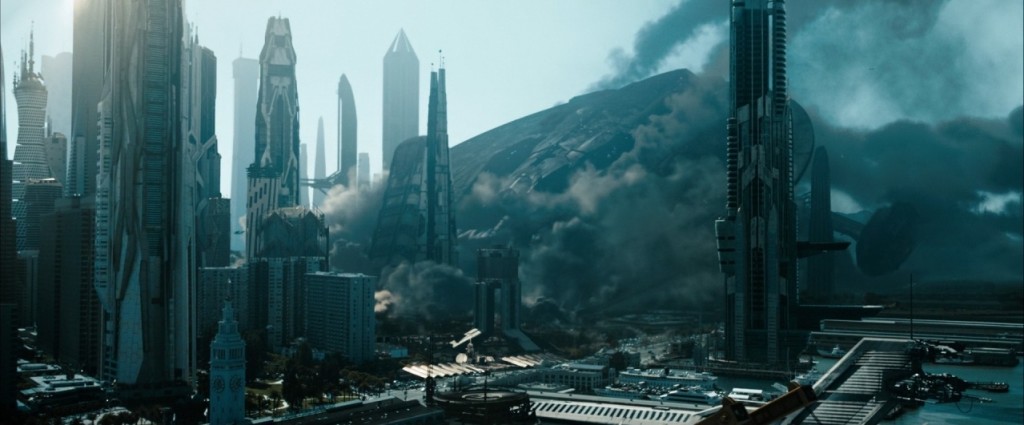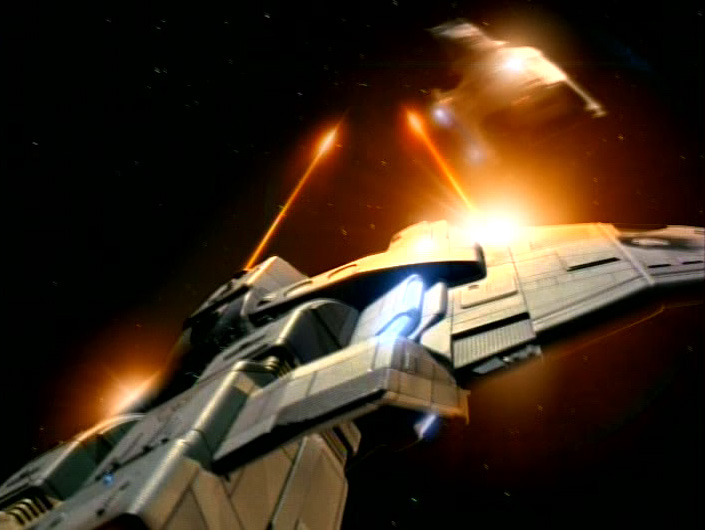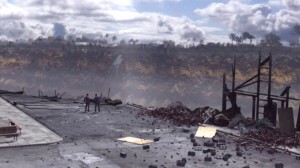Star Trek is an enormous and complex cultural entity whose impact on politics, technology, and storytelling are undeniable. It’s also as flawed and problematic as any other massive media franchise. Lifelong Trekkie and Deadshirt Editor-in-Chief Dylan Roth attempts to make sense of it all for die-hards and outsiders alike in his bi-weekly column: Infinite Diversity.
“”History has shown us that strength may be useless when faced with terrorism.”
– Captain Jean-Luc Picard (“The High Ground” [TNG])
Though it often features space battles and firefights, Star Trek has always been a story about peace and compassion. Violence is typically the our heroes’ last resort when resolving conflicts. However, there are a number of stories in the Star Trek canon in which, due to impossible circumstances, individuals or small groups turn to grand statements of violence to achieve their goals. The series’ point of view on terrorism has shifted over the decades, but Trek has typically taken strides to represent both target and perpetrator as people, with points of view and motivation.
Before 2001, Americans saw terrorism as something that happened to other people in other places, and we were perhaps more flexible when considering that thin line between “terrorist” and “freedom fighter.” Since the Federation typically stands in for the United States in Star Trek‘s political allegories, our lead Starfleet characters often take the same stances we would, but with that evolved diplomatic detachment they’re so famous for. So, as terrorism became a more important subject in the American consciousness, so did it become a more prominent element in Star Trek, beginning as an occasional diversion, growing into a recurring theme, and finally becoming the franchise’s main preoccupation.
SPOILERS AHEAD for select TNG and DS9 episodes, ENT Season 3, Star Trek (2009), and Star Trek Into Darkness.
Terrorism was hardly a fixture in the American lexicon during the time the original Star Trek was in production, being the height of the cold war. The issues of the day then were proxy wars, the arms race, and mutually assured destruction. Likewise, conflicts on Trek were usually between governments and civilizations, or with individual villains on personal crusades. Though times had changed by the late eighties and early nineties, The Next Generation still wasn’t too interested in terrorism as an issue, dedicating only one episode to exploring the concept in detail: 1990’s “The High Ground.” “The High Ground” is an academic look at terrorism, serving as a sort of a non-judgmental crash course on the cycle of violence works, and on the “terrorist”/”freedom fighter” distinction. The episode lacks a clear thesis or resolution, but is sympathetic to both sides of the conflict, which is portrayed as two passionate groups having irreconcilable differences.
Trek wouldn’t dive deep into the subject of terrorism until a few years later, during the build-up to the darker, edgier spin-off, Deep Space Nine.
Liberté, ou la Mort
The saga of Bajor and Cardassia is one of the most complex and long-running storylines in Star Trek, affecting all three NextGen-era series and providing the main focus for Deep Space Nine. Bajor is a peaceful planet that is conquered and occupied by the Cardassians for generations, during which the abused and oppressed Bajorans wage a violent resistance. When the Cardassians finally leave Bajor, the planet is a wreck and its people now a bitter, suspicious culture, reluctantly forced to ally with the Federation to get back onto their feet.
The audience’s main viewpoint character from Bajor is Kira Nerys, the first officer aboard space station Deep Space 9. Nerys has been fighting the Cardassians “since [she] was old enough to pick up a phaser,” and while she is typically referred to as a “resistance fighter,” the Cardassians label her a terrorist, and from their point of view it’s not hard to understand. As a member of the Shakaar resistance cell, Kira has taken part in a number of raids against Cardassian military operations, some of which led to civilian deaths. After the occupation, Kira regrets much of what she had to do to win freedom for her people, but still believes that that it had to be done, that her actions were justified by circumstances.
It’s hard to argue against her, too, and her story is framed in such a way that the audience is meant to agree. Kira is portrayed as a heroic, honorable woman who values life, but who chose not to stand by as her people were enslaved. Make no mistake, the Cardassians committed far worse atrocities than the Shakaar ever dreamed of, up to and including forced labor/death camps akin to Auschwitz. No one watching would blame Kira or her compatriots for taking up arms against such an evil, even if it meant some Cardassian civilians and Bajoran collaborators would have to die along with the butchers.
“How would Kira have changed post 9/11? If the show was still on in 2001, would they have changed her? And if the show had come on after 9/11, would they even have had the character? That’s a question I have. Kira was called a freedom fighter, but she was a terrorist.”
– Nana Visitor (the actress who portrayed Kira Nerys) in a 2011 interview with StarTrek.com
Deep Space Nine came to a close in 1999, when organized terrorism was still a sort of abstract concept to many Americans, so Kira, who is framed as a heroic character, probably never seemed threatening to the audience of its time. She is, after all, an underdog in an obviously righteous revolution, as well as the victor, which typically determines whether or not you call a person a terrorist or a revolutionary. But once the War on Terror became a focal point in our national consciousness, words like “insurgent” took on a very different meaning. Given this era of Trek‘s generally toothless approach to contemporary issues, it’s probably that references to Kira’s past in the resistance would have come to an all-stop if the series had still been on the air in 2001, and that, if it had begun in 2001 or 2002, the series would likely have had a completely different premise, since occupation and resistance were such an essential element to Deep Space Nine as a whole.
Indeed, Kira Nerys wasn’t the only sympathetic character in nineties Trek to commit acts of terrorism. After a peace treaty between Cardassia and the Federation sees the two powers trade colony worlds near the border, some Federation colonists choose to renounce their citizenship and live under Cardassian rule rather than leave the homes they’ve spent a generation building. But the Cardassians quickly begin abusing and even killing the colonists in an effort to chase them off the land. The Federation, valuing the peace treaty over the lives of the errant colonists, refuses to act on their behalf, so the colonists take up arms themselves, forming the resistance group called the Maquis.
The Maquis are portrayed with sympathy from the very beginning, even convincing established Enterprise crew member Ro Laren to join their cause. Indeed, most of the Maquis’ leaders are Starfleet officers who resign their commissions to fight for the colonists’ freedom. Later, in Star Trek: Voyager, half of the principal cast is made up of Maquis who are forced by circumstance back into serving aboard a Starfleet vessel. Though there’s some friction at first, before long the two crews join together into one, big, happy family, with the conflict between the two factions all but forgotten.
But in keeping with nineties Trek (and nineties America), the Federation is not the direct target of the terrorist action. The Maquis’ enemy are the Cardassians, and they avoid conflict with Starfleet whenever possible. It’s Starfleet (like the US military) that feels forced to intervene in what is essentially not their fight, in order to protect their political agreement with the all-around nasty Cardassians. It never even occurs to the Federation that they might become the victim of terrorism themselves; the only threat in their minds is a declared war by another galactic power.
Later, when the Federation finally does experience the shock of random, mass violence on their own soil, it’s part of a prelude to a full-scale war with the Dominion, not a true insurgency. The idea that a small, ragtag group of motivated individuals like the Maquis could sting at the heart of the mighty Federation probably never crossed the writers’ minds in 1996, though they did get the opportunity to tell a compelling story about how a sheltered society like Trek‘s Earth responds to the sudden, constant threat of violence. (Essential viewing: “Homefront”/”Paradise Lost” [DS9])
Archer’s War
“I can’t wait to get in there, Captain – find the people who did this. And tell me we won’t be tiptoeing around. None of that non-interference crap T’Pol’s always shoving down our throats.”
– Commander Charles “Trip” Tucker III (“The Expanse” [ENT]”)
The fifth Star Trek series, Enterprise, premiered on September 23rd, 2001, just two weeks after the 9/11 attacks. (When the debut episode first aired, there was even a PSA during a commercial break in which star Scott Bakula urged viewers to give blood for the relief effort.) The average American’s perspective on terrorism had changed from an outside observer to a wounded victim. Starfleet, being the in-universe proxy for the US, would likewise become more directly affected.
Enterprise waited until the end of its second season in 2003 to attempt to address post-9/11 America, but when they did, they were not subtle about it. In “The Expanse,” Earth is attacked by a mysterious probe of unknown origin, which burns a slice through the Americas and kills seven million people, before self-destructing. Humanity is shocked and altered by this unprecedented act of violence. Captain Jonathan Archer discovers that the perpetrators are Xindi, a race they’ve never met from a treacherous part of space they’ve never encountered, and Enterprise is dispatched on an urgent mission to stop them from sending a more powerful weapon that would destroy Earth outright.
The Xindi arc, which took up the entire third season, was far more ambitious and compelling than the lazy, unimaginative Enterprise stories that had come before. The normally bland Captain Archer is forced to betray his own principals in his quest to stop the Xindi, resorting to torture, manipulation, and even murder, representing the USA’s no-holds-barred war on terror and all the ugliness it brought out in us. Annoying sidekick “Trip” Tucker loses his sister in the Xindi attack, and has trouble reconciling his own personal loss with the larger cultural one, feeling guilty for valuing her life over all of the other innocent victims of the attack. The deeper Enterprise reaches into the Delphic Expanse, the more they must face their own worst selves, and hope that, when the journey is complete, that it will have been worth it.
The thing that elevates the Xindi arc is the way that it plays with the audience’s expectations. When the story begins, Archer and the crew are blinded by rage, willing to take out their anger on any Xindi they meet, whether they had anything to do with the attack or not. But as the season goes on, the audience is treated to more information about the Xindi and their motives, how they’ve been misled by extradimensional beings with their own purposes, and eventually Enterprise teams up with the majority of Xindi factions to stop a paranoid few from destroying Earth. The crew has to learn to heal, to think more clearly about who the enemy is and why they do what they do. This is something that a lot of viewers probably needed to do, too, in their own lives.
The arc is not without its missteps, but overall it stands as a fairly effective document of post-9/11 attitudes, while still finally preaching compassion and diplomacy over vengeance.
Khanpassion
It’s not surprising that, when the Star Trek franchise returned to the big screen in 2009, that the stakes would be higher, the explosions bigger, and the body count far greater. While the years immediately following the 9/11 attacks avoided shocking or offending audiences with images of shattered cities and falling skyscrapers, by the time Star Trek Into Darkness was released in 2013 it was pretty much a given that every blockbuster action film would attempt to tap into World Trade Center imagery or themes in some way.
Into Darkness leans hard into War on Terror allegory, trying (to limited success) to craft a message about the dangers of disproportionate military responses to terrorism, of drone strikes, of losing oneself to vengeance in the face of unspeakable violence. The film ends with the deadly superhuman Khan crashing a massive starship into and leveling a city, plowing through buildings and covering San Francisco in a dense cloud of debris, probably killing thousands, but the film ends with our heroes sparing the life of the perpetrator and taking him into custody rather than summarily executing him. The film itself even takes steps to humanize Khan by giving him a cause to fight for: his beloved crew.
It’s also worth noting that the violence in Into Darkness is set into motion by a power-hungry Starfleet Admiral who secretly sets Khan loose in order to shock Starfleet into battle-readiness, further throwing sympathy in Khan’s favor and placing the blame for the death toll more in the hands of an eager military, rather than the obvious terrorist. (The script was co-written by Robert Orci, who thinks 9/11 was an inside job, so, make of that what you will.)
It’s hard to imagine Into Darkness being written back in 1995, when the Maquis storyline was in full swing. From the Federation’s perspective, the Maquis dilemma is about trying to maintain peace while never really being in danger themselves. The Federation of Into Darkness is very much in danger, from just this one man. The lesson they have to learn is to not lose themselves to the fear and doubt that comes with the knowledge that there’s no such thing as complete safety, and that all you can do in the face of danger is just move on and try to be the best version of yourself rather than become your enemy.
While terrorism has become a more prominent element in the canon of Star Trek, the franchise’s commitment to compassion and understanding has rarely wavered. Even as its American creators saw the world change around them, and their place in it become forever altered, Trek hasn’t lost its head, remaining a laboratory for exploring our own hopes and fears and for exorcising cultural demons. One can only hope that future installments can continue to keep a level head and preach peace first and violence last, even as the real world gets harsher and more terrifying.
Next time: A look into Star Trek 3 director Justin Lin’s body of work, and what it can tell us about the future of the film series.
Infinite Diversity will return in two weeks! Follow @DeadshirtDotNet on Twitter to keep up with what’s new here on Deadshirt, and feel free to tweet @DylanRoth with suggestions for future topics for Infinite Diversity, or just to talk about Trek. He truly never gets tired of that.






